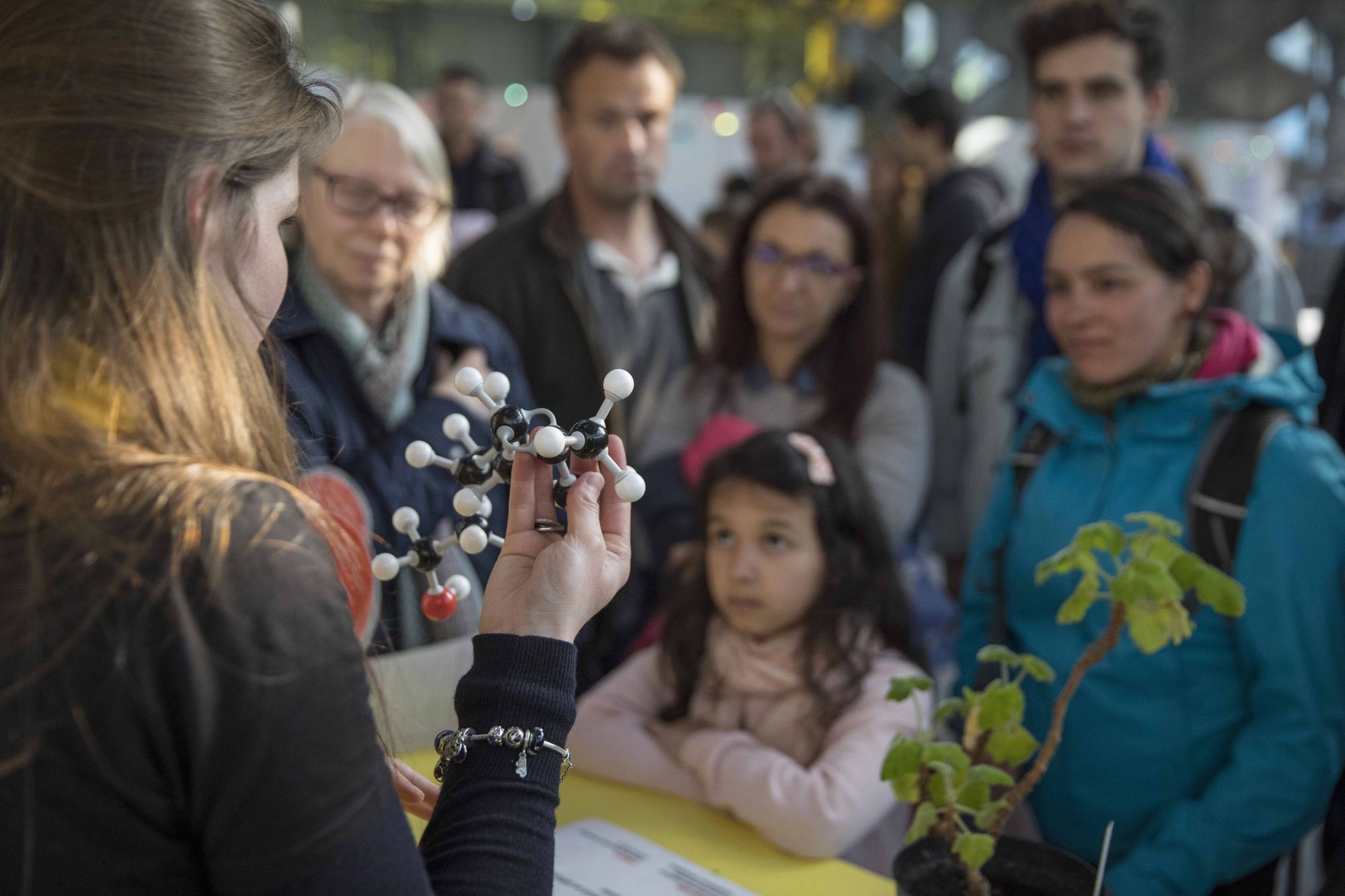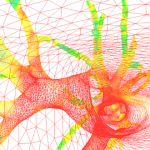When Researchers and Visitors Stay up all Night
 Every year, the European Researchers’ Night allows scientists and curious visitors to meet in over 200 European cities. The STORIES project, selected last May through the H2020 MSCA-NIGHT-2018 call for projects, will enable the CCSTI La Rotonde to join the national network and become the regional coordinator for this event, beginning in September 2019. As part of this project, Julie Fortin, in charge of promoting research at Mines Saint-Étienne, is working to create mediation models that encourage direct meetings between researchers and the general public. Meetings that benefit both visitors and researchers.
Every year, the European Researchers’ Night allows scientists and curious visitors to meet in over 200 European cities. The STORIES project, selected last May through the H2020 MSCA-NIGHT-2018 call for projects, will enable the CCSTI La Rotonde to join the national network and become the regional coordinator for this event, beginning in September 2019. As part of this project, Julie Fortin, in charge of promoting research at Mines Saint-Étienne, is working to create mediation models that encourage direct meetings between researchers and the general public. Meetings that benefit both visitors and researchers.
What is the European Researchers’ Night?
Julie Fortin: The European Researchers’ Night is organized every year on the last Friday of September, from 6pm to midnight in over 200 cities in Europe. As part of the Marie Sklodowska-Curie Actions under the H2020 program dedicated to promoting researchers’ careers, Mines Saint-Étienne and the associated CCSTI La Rotonde will become the event coordinators of the 2019 edition for the Auvergne Rhône-Alpes region, joining the ranks of the 13 other French CCSTI and universities participating in the event.
The goal of this event is to offer the general public an opportunity to meet the researchers directly, without any intermediaries. Each year a common theme is selected collectively: in 2018, for example, the theme is 1001 stories. The mediation models are chosen in keeping with the annual theme. Each participating institution is free to customize the event in its own way, but all must offer a friendly atmosphere that fosters connections between researchers and the general public. The idea is to promote more intimate models. Conferences, for example, are avoided, because they offer more of a monologue than a discussion!
What mediation models do you implement to foster interaction between the researchers and the general public?
JF: We are developing new mediation models for the European Researchers’ Night and we are also using a lot of ideas from Ramène ta science, a similar annual event held at La Rotonde, that allows small groups of visitors to meet with researchers.
For example, we have a model called “The Scientist’s Suitcase” in which the scientists bring different objects in their suitcase to help them tell visitors about their field of research. For example, I am a geologist, so I can bring my field tools, like a hammer or a sample from my laboratory. The researchers can also bring anecdotal objects that reveal their daily life as a researcher or more personal things that show what inspired their passion for science or to talk about other hobbies.
We also have another model called “Draw your Science”, in which scientists use drawings to highlight key words to help them talk about their daily experience and field of research… Here again, the scientists choose what they want to share. Other models, like “The Scientist’s Cart” allow visitors to witness the scientist carrying out a lab experiment or “Experimenting with Science” in which the visitors themselves take on the researcher’s role by collecting and processing data… We also organize the “Science Xpress” activity, a type of speed-dating between researchers and groups of visitors!

A Mines Saint-Etienne student presents an experiment at the “Ramène ta science” event. Photo Credit: Pierre Grasset for La Rotonde.
Are these mediation models meant to contradict the impersonal image that the general public sometimes has of science and scientists?
JF: Yes, these mediation models that promote discussions and proximity with the public allow us to introduce a human aspect and debunk the myth that represents scientists as shut up in their labs! We also want to show that scientists are not the only ones working in the field of science, there are also technicians, research engineers, etc. They are all represented within Mines Saint-Étienne. For the European Researchers’ Night, we are also working together with universities, engineering schools, an art and design school, an architecture school, the Cité du Design, and a start-up incubator… Some design researchers, for example, show how a product is developed or experimental approaches. Students also contribute, presenting projects they completed during their training, and startups are also involved in the event. The goal is to show the approach they take, from the idea through to the final product, as well as the connections between the world of research and companies.
For the European Researchers’ Night, we also hope to add a European space. We are already hosting many foreign researchers at Mines Saint-Étienne and we want to show our visitors that scientific research also involves international collaboration!
How do the researchers see these meetings with the public?
JF: We started the “Ramène ta science” project with a core group of researchers who were already involved in scientific popularization projects. These researchers were thrilled and encouraged their colleagues to participate! Other researchers have gotten involved after enjoying the experience as visitors. Our PhD students are also invited to participate in the context of training on communication and scientific popularization.
All the participating researchers come with the intention of sharing their work and the visitors can sense that and make it worth their effort! The visitors are curious and are thrilled to communicate with scientists. The participants also know that we are here to help them prepare before the event, we do not just leave them to fend for themselves. We help them prepare through individual meetings and help them develop potential mediation ideas and adapt them to their type of popularization and their audience.
However, the simplification process is still difficult for some researchers. Some researchers tell us that they prefer a high school or middle school audience and we adapt to meet these requests. We respect each individual’s personality and desires.
What do the researchers take away from this experience?
JF: The researchers tell us that this experience offers them interactive techniques they can use with their students. But above all, in preparing for these popularization activities, they realize that they cannot say everything they want to. Often, they have become so specialized in their field that even other scientists cannot necessarily understand… They must learn to target their message! The researchers tell us that explaining their field of research in the simplest and fastest way possible forces them to check their own understanding of certain concepts in their field. In addition, sometimes simple questions from the audience help them see some of their problems in a different light! Not that his leads to new fields of research, but it can at least open some new perspectives…
Also read on I’MTech
[one_half]
[/one_half][one_half_last]
[/one_half_last]





Leave a Reply
Want to join the discussion?Feel free to contribute!